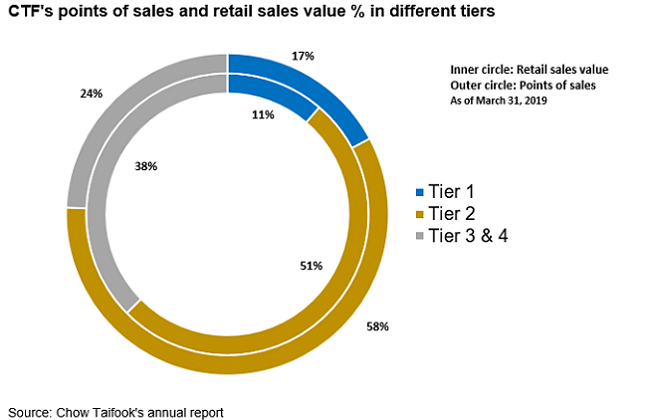Chinese retail jewelers sell lower karat gold
August 26, 19
The World Diamond Council published a report, written by WGC Research Manager Ray Jia, that during the past five years, Chinese retail jewelers have seen their profit drop. Some retailers have even seen net profits shrinking over the period. Most of them have made efforts to address this by introducing high-margin and innovative products "such as 3D-hard gold and "5G" gold."
Jia noted that in recent years, many Chinese jewelry retailers have expanded their presence in "tier three and four cities." Chow Tai Fook (CFT), a Hong Kong-based retail jeweler, added 251 points of sales (POS) in lower tier cities in 2018 compared to only 50 in tier one cities. Lao Feng Xiang, another large retail jeweler with 3,521 POS domestically, also prioritized expansion into lower tier cities.
"While tier one and two cities are better positioned economically, politically and socially, tier three and four cities shouldn't be disregarded. As shown above [in the illustration], consumers from lower tier cities contributed significantly to the overall sales for CFT in 2018. And other jewelers have told us the same." Jia wrote.
Jia said that the Chinese government lists boosting consumption as a vital policy goal. Lower tier cities and rural areas have been the government's focus as these markets have larger room for consumption growth: disposable income growth rates are higher when compared with higher tier cities. Because faster growing income means an improvement in the quality of life, and because consumers in these cities are spending proportionately less of their incomes on food, they are able to divert more of their disposable income towards other goods, such as gold jewelry.
This truth seems to be reflected in retail sales data as sales in lower tier cities (tier three and below) in proportion to total retail sales in China, are rising. In 2017, more than 50 percent of total retail sales came from lower tier cities.
Data indicate that jewelry consumers in lower tier cities are much more traditional than those in big urban centres, preferring high purity products. To them, value preservation outweighs design. But demographic changes could be leading to changes in tastes. And it is increasingly becoming clear that younger generations are at the heart of this change. Jia wrote further that WGC consumer research in 2016 showed that instead of the traditional 24-karat gold jewelry, 18-karat gold jewelry is the popular choice among younger generations. The lower entry cost and broader array of designs made 18-karat gold jewelry more attractive to younger consumers with a desire for enhanced styles.